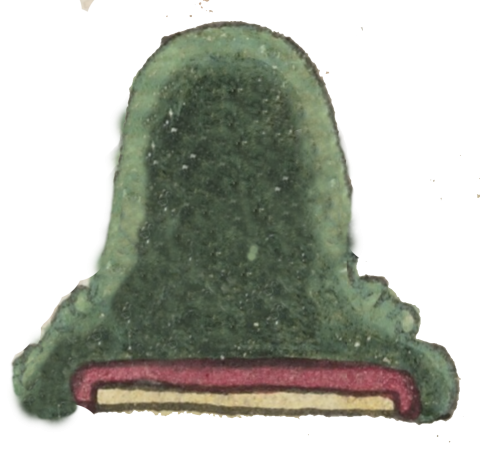tepetl (Mdz2r)
This element for hill or mountain (tepetl) has been carved from the compound sign for the place name, Tenayocan. The hill is not a phonetic contributor to the place name, but a silent locative. We have removed the ramparts from the center of the hill in the original glyph; we have also repaired the loss of green paint before the part that was removed. What remains is a classic bell shape, painted a two-tone green, with red and yellow horizontal lines at the bottom. The curling, rocky outcroppings that normally appear in the middle of the slopes of the hill on the right and left are here lower, closer to the final curve of the bell. The red line wraps around the yellow line at each end, following the curve of the bottom of the bell shape.
Stephanie Wood
This glyph is not a phonetic part of the place name. It may be intended to indicate that this community is an altepetl. The rocky outcroppings on the left and right slopes provide a phonetic clue ("te") that this glyph is meant to be read "tepetl." Of course, mountains also typically have rocks. Regarding the yellow and red horizontal stripes, please see the article on Interiors.
Stephanie Wood
by 1553 at the latest
Stephanie Wood
mountains, hills, montañas, cerros, altepetl, stones, piedras, rocks, rocas

tepe(tl), hill or mountain, https://nahuatl.wired-humanities.org/tepetl
te(tl), rock or stone, https://nahuatl.wired-humanities.org/content/tetl
el cerro o la montaña
Stephanie Wood
Codex Mendoza, folio 2 recto, https://codicemendoza.inah.gob.mx/inicio.php?lang=english
The Bodleian Libraries, University of Oxford, hold the original manuscript, the MS. Arch. Selden. A. 1. This image is published here under the UK Creative Commons, “Attribution-NonCommercial-ShareAlike 3.0 License” (CC-BY-NC-SA 3.0).


